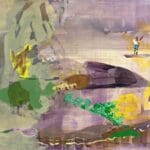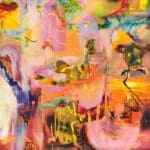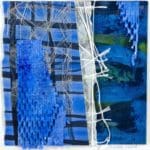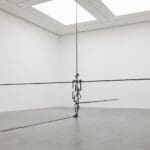Acrylic On Canvas or Paper -vs- Digital Art
Jay Zerbe, Abstractionist & Instructor Makes Significant Announcement Following 60-Year Career As A Professional Abstract Artist
Life isn’t static, nor are the decisions artists occasionally must make to sustain their practice and preserve the integrity of their work and artistic legacy.
Jay Zerbe has created a wide range of work during his six-decade career as a professional artist, driven by his natural passion, curiosity, and love of art, abstraction, and chaos in nature. His work includes illustration drawings on paper, collages constructed of stapled found materials, and later in his career, collages created from clippings of digital images taken of various original paintings and assembled into new compositions he refers to as eCollage.
Looking closely, one brilliant effect demonstrated in Jay’s eCollage work is the natural brush strokes, dripping, and paint textures carried over from the image clippings of his original acrylic on canvas work. In his eCollage, he creates a new digital collage displaying a representation of the physical processes of other works of his art. To truly understand this master’s technique, one must visit his portfolio at jayzerbe.com and examine his acrylic on canvas and acrylic on paper work, within examples of his eCollage work, where fragments of his physical painting processes are visible.
Throughout his career, Zerbe’s primary focus and the foundation of his practice has been his acrylic on canvas paintings, which have received notable gallery representation and now exist in private collections globally. Today, he continues to create acrylic on canvas art, material collage, and digital eCollage from his Indiana studio, surrounded by his beloved antiques, private art collection, meadow, and natural pond.
Like most artists, he wonders how his work will continue to gain recognition in an ever-changing and expanding world of on-demand automation, AI, and technology, and how it all relates to the traditional gallery system.
Historically, gallery and dealer representation have been pivotal in introducing artists and helping to establish their reputation among buyers in known art markets. However, among the majority of people, most of society’s growing population cannot afford to buy original gallery art. As the wealth gap grows, new generations and expanding populations will miss opportunities to experience the joy and wonder of discovering, appreciating, owning, and collecting original art.
Pair this with the reality of space and supplies, as well as the high cost of sustaining a professional art practice, and one can see how visibility and awareness can be a life force for professional artists driven by a passion for creating art but also experiencing the same economic challenges we all do.
Professional artists often consider generating awareness of their work and earning revenue by offering commercial print reproductions of their original art. And the private collection of high-quality archival print editions is growing.
Combined with traditional gallery and agent representation, marketing limited edition, ethically sourced commercial prints of an artist’s original art can promote greater awareness of the artist’s brand while reinforcing, and for some artists increasing, the value of their original work because of the added exposure and expanding market demand for limited numbered fine-art editions.
The desirability of the original art, limited print offerings, and the artist’s reputation are primary forces that determine and drive the valuation of print editions making them an easy choice for collectors.
Whether or not to make archival prints of original artwork is the individual choice of each artist. Some hold tight to traditional practices, and some see the inevitable evolutionary changes in our global communities. While making archival prints has its benefits, it also has potential drawbacks that might result from over-commercializing the artist’s work, thereby over-saturating product and brand awareness. Ultimately, whether or not to make archival prints should be based on an artist’s goals and circumstances. Misused, producing commercial art products can lead to over-saturation and devaluation of the artist’s work. Used correctly, it can be a strategic method for growth.
In the following Q&A, we ask Jay about his decision, after 60 years of practice, to now, for the first time, offer high-quality, limited-edition archival prints of his original acrylic on canvas and acrylic on paper artwork from his studio inventory and his own private collection.
Q. Jay, thank you for speaking candidly with the artistvenu community and beyond about this pivotal change in your art practice. Many enjoy the process behind your digital eCollage but may also agree that your work’s foundation exists within your original acrylic on canvas and acrylic on paper paintings.
You have never released limited edition archival prints of your original canvas and paper paintings, so why now?
A. Throughout my life, I have noticed constant changes in our society, the world, and even the universe around us thanks to exploration developments such as the Hubble and the James Webb Space Telescope. With my husband’s passing, I often think of the world, my place in it, and how the art I love so much fits and will continue to exist in the awareness of others and future generations. I am grateful for my many gallery opportunities over the years. I seek to support these professional relationships, but I also see a need and way to help promote awareness of abstraction and art collection by introducing my work to a changing world and newer generations in an affordable and controlled offering. I can do this by releasing limited editions of some work in my portfolio.
prints selectively and at a smaller scale from the original canvas and paper works. This way, others can afford and enjoy collecting my work.
First-Time Offering
Archival Limited Editions of Original Acrylic on Canvas & Acrylic on Paper Paintings
Q. What exactly are you releasing, and what do you mean by “controlled offering”?
A. Paintings previously sold and pieces with current Gallery representation will be excluded from the limited edition print offer. My remaining studio and private collection inventory contains hundreds of paintings that will be selectively reproduced and released as limited-series archival prints.
artistvenu will reproduce a controlled offering of 5 “Museum Quality Gallery Edition Archival Prints with hand signature” and a total of 24 “Archival Collectable Prints with embedded signature – which are at a more affordable price”. I’m excited to have an opportunity to share this inventory in the form of archival prints.
Q. How will this offering differ from the original work, and are you concerned that it will affect the valuation of your original acrylic on canvas paintings?
A. It is important to note that the limited edition archival prints are in a smaller size format than the originals. The maximum size of the Gallery Edition and Collectable Prints will be 17 x 22 inches including border compared to the original canvas and paper works. which are much larger scale in most cases, 24 x 24 inches or larger. Some of my canvas work exceeds 60 inches in size.
I believe that a quality-controlled limited quantity release will help increase the awareness and value of my original work and I’m looking forward to establishing a relationship with new collectors! I will only ever release limited edition archival prints selectively and at a smaller scale from the original canvas and paper works. This way, others can afford and enjoy collecting my work.























![Artist Shares Secrets of How To Draw Incredibly Realistic Portraits [Interview]](https://artistvenu.studio/wp-content/uploads/2023/12/Screenshot_242-150x150.jpg)







